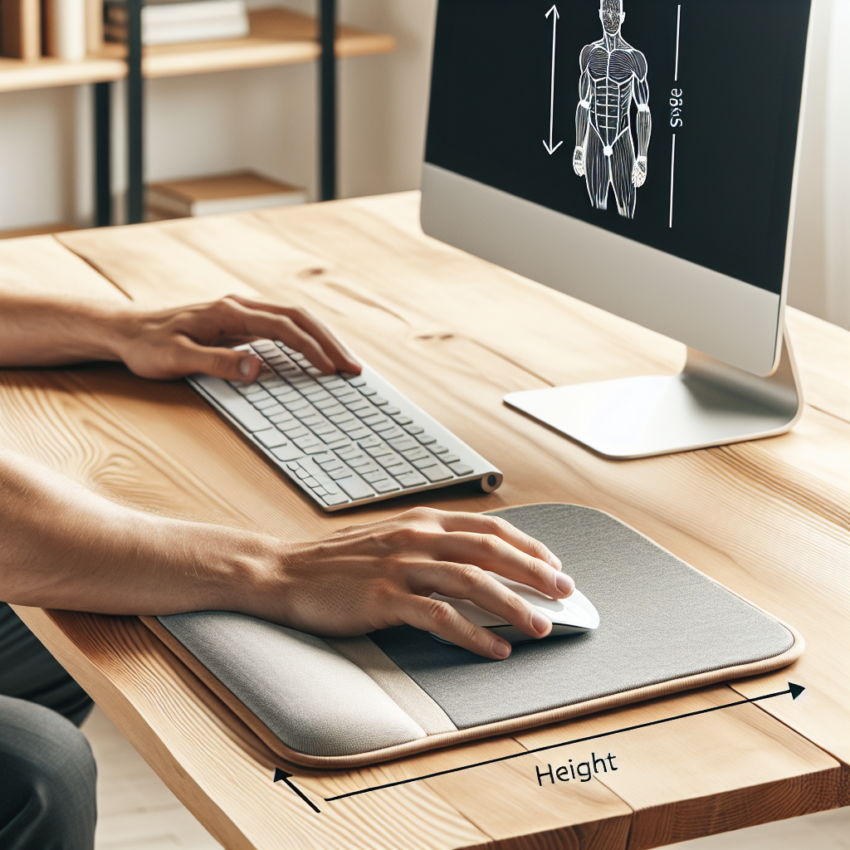The use of ergonomic mouse pads with wrist rests has become essential in modern workplaces, especially for those who spend long hours on computers. The right height for a wrist rest can significantly impact a user’s comfort and productivity by promoting proper wrist alignment and reducing strain. But what is the ideal height for a wrist rest on an ergonomic mouse pad? This article will delve into this topic, providing insights and tips for selecting the perfect wrist rest for your needs.
| Factor | Recommended Range |
|---|---|
| Wrist rest height | 1 to 1.5 inches |
| Mouse height (from desk) | 1-2 inches lower than elbow height |
| Elbow angle | 90 to 110 degrees |
The Importance of Wrist Rest Height
A wrist rest that is the correct height plays a crucial role in maintaining optimal wrist positioning. When typing or using a mouse, it’s vital that the wrist remains in a neutral position, not bent upwards or downwards. This means that the height of the wrist rest should allow the user to keep their wrists straight while using the mouse. An improper height may lead to discomfort and long-term issues like repetitive strain injuries (RSI).
Factors Influencing Ideal Wrist Rest Height
Several factors affect the optimal height for a wrist rest. Understanding these can help in selecting the right ergonomic mouse pad:
- Desk Height: The height of your desk plays a significant role in determining the appropriate wrist rest height. A higher desk may require a slightly taller wrist rest.
- Chair Height: The height of your chair will also affect how you position your arms and where your wrists naturally fall. Your chair should ideally allow your elbows to rest at a 90 to 110-degree angle.
- Mouse Height: When using a mouse, it is crucial that the mouse height is lower than the elbow height. Aim for a difference of about 1-2 inches.
Finding the Ideal Wrist Rest Height
To find the ideal wrist rest height, consider measuring the distance from the surface of your desk to your elbows when seated comfortably. Here is a simple method to find the right height:
- Sit in your chair with your feet flat on the ground and your back straight.
- Lower your arms so your elbows are at an angle of 90 to 110 degrees.
- Measure the distance from the desk to the bottom of your forearms to find the optimal wrist rest height.
- Subtract from this measurement the recommended height of 1 to 1.5 inches for the wrist rest.
Types of Wrist Rests: Which One is Best?
When selecting a wrist rest, it’s essential to consider the material and type:
- Gel Wrist Rests: These offer soft support and mold to the shape of your wrist. They are easy to clean but can heat up during long use.
- Memory Foam Wrist Rests: These provide excellent support and contour to your wrist while allowing for better airflow.
- Hard Wrist Rests: While not as common, hard wrist rests can provide a stable platform but may lack the comfort associated with softer materials.
Adjustability and Customization
With technological advancements, some ergonomic mouse pads now come with adjustable wrist rests. This feature allows users to customize the height to their preference and body type. Additionally, many options allow for vertical adjustment, catering to varying desk and chair heights.
Testing Different Heights
Before settling on a specific wrist rest height, testing several options may be beneficial. Here’s how you can do this:
- Try using a few different wrist rests at various heights.
- Pay attention to your wrist position and comfort level during use.
- Take notes on any discomfort experienced over time with each height.
- Choose the option that allows for natural wrist alignment without straining.
Conclusion
Choosing the ideal height for a wrist rest on an ergonomic mouse pad is vital for ensuring comfort and preventing strain during long periods of computer use. By considering factors like desk and chair height, mouse positioning, and personal preferences, you can find the perfect support that allows for a relaxed, neutral wrist position. Testing different options can also help identify the best fit for your specific needs, paving the way for improved productivity and a healthier workstation.

